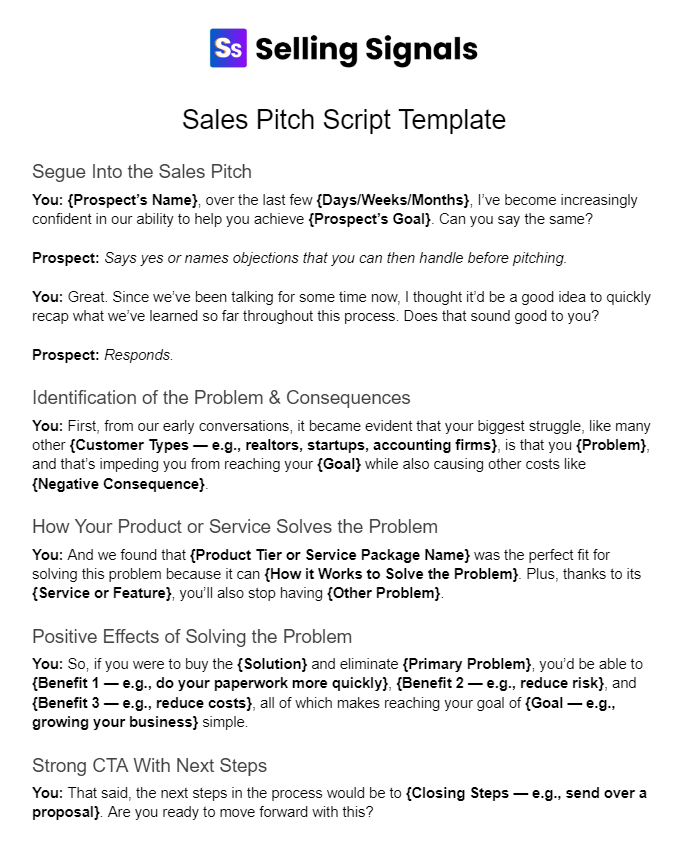-
News & Trends -
Sales -
Marketing Related Topics -
B2B Software Guides Related Topics -
Free Tools & Resources -
- About Us About Us


A sales pitch script is a reusable set of pre-written language and prompts that helps salespeople deliver persuasive sales pitches to late-stage prospects they’re trying to close. It outlines the five parts of a sales pitch: the segue, the problem, the solution, the benefits, and the call-to-action. Most sellers create one script for each solution they sell and personalize it for each specific prospect. They may also create alternative scripts for common scenarios.
This article is designed to help you write a script that you can fill out and personalize for each specific prospect you’re pitching. For more detail on how to give a pitch, check out our guide on the sales pitch, including the steps to create and deliver a pitch as well as examples.
We created a free sales pitch script template that you can use as the foundation of your own sales pitch script. While it’s easy to change the script’s language and customize it to your needs, you can also use it “as is,” because we kept the language generic and filled the script with prompts (blank spaces). The script outlines the five most crucial components of a sales pitch and uses a professional yet conversational tone. To access it, click the script below.

There’s an optimal way to compose a sales pitch script that leads to an effective sales pitch. The standard script includes the following sections: segue into the pitch, problems and consequences, how your solutions solves the problem, the benefits to be gained, and a call-to-action (CTA), which is usually to take some action that initiates the purchasing process.
Below is the standard sales pitch script format:
A sales script with the above elements will help you effectively persuade prospects to move further along your sales process. The components established, let’s now go over how to create your own sales pitch script.
There’s a seven-step process salespeople should follow to efficiently craft a sales pitch script. This includes choosing one product or service, picking a target audience, finding common problems, learning how your solution solves the problems, identifying benefis, writing out each element of your script, and practicing. Keep in mind that your finished script should include many blank spaces (aka prompts) that allow you to personalize the script to each prospect.
Although your pitch script will likely include prompts that allow for quick personalization to any given situation, it’s still best practice to create one pitch script for each of your product lines or service packages. That’s because different products and services might require different language and rhetorical techniques for the pitch to be as effective as possible.
For example, in a script for selling enterprise tier software, the salesperson might feel they have less certainty about any prospect’s readiness to move forward with a sale, because the product is so intricate. Thus, they write the following in their CTA section: “On a scale of 1-10 how ready are you to move forward?” This helps them gauge the situation. But, in their script for a transactional product, they might simply write “Should we get a proposal sent out to you today?”
After picking one specific product or service, choose one target audience as well. People in different positions and industries respond differently to language. Busy C-suite execs of enterprise companies might just want a fast, barebones explanation of why they should buy, so your pitch script could include less pre-written language and fewer prompts — e.g., just a {Main Problem} prompt instead of two or three.
Over time, you should create multiple sales pitch scripts, one for each customer persona and product/service combination. So a salesperson with three services to sell and three customer personas will create nine scripts. This might sound tedious, but it really isn’t, because you’ll do most of the legwork when crafting the first one. The others are just iterations of it.
Because it’s so late in the sale, you’ll know your prospect’s problem inside and out. Therefore, your scripts should use plenty of prompts like {Main Problem} that you fill in with the specifics of that prospect’s issue. That said, it’s still smart to form a list of common problems and consequences, as this can help to jog your memory when personalizing the script during preparation for the call, or even provide inspiration for ways to agitate or expand on an issue.
To come up with common problems and consequences, use these methods:
After this phase of research, organize the problems and related consequences into a list in a Google or Word document. Then hyperlink to it at the bottom of your sales pitch doc, or stick it in the same folder as the pitch script. Look the list over whenever you’re personalizing a pitch script for a call.
By reviewing case studies, talking with fellow sales reps, or interviewing happy customers, learn and record how this script’s specific product or service solves each of the most common customer problems that you figured out in step two. And write these out in two simple sentences — no jargon. That way, filling in the “solution” section for an upcoming call with a prospect will be easy. And your explanation of how X solves Y will be convincing and sharp.
Another type of prompt you’ll use in your script is a “benefit” prompt. Of course, while preparing for a call, you’ll replace these prompts with the results that your prospect has expressed the most interest in experiencing. But it helps to have a list of impactful benefits, attached to the specific product or service, to draw from during the personalization process.
There are many ways to find these benefits, including holding interviews with happy customers, referencing your customer profile or marketing materials, and sending out surveys.
Then write out at least eight that your customers experience and keep them in a document you can easily reference when personalizing the script that you’ll write in the next step.
This is the most intensive step in the sales pitch script creation process. Here you’ll create each of the five sections of your script: segue, problem, solution, benefits, and CTA. Consider using our pitch script template from the beginning of the article as a guide for writing your pitch script. Stay in the ideal range of 220-280 words (2-3 minutes in total), and know that when you personalize it for a prospect the script will be longer because you’re filling in the blanks.
Write out these five sections of your pitch script:
Keep the pre-written language friendly and professional, and be sure to include a lot of prompts (blank spaces) so that before every meeting you can custom-tailor the script with information you’ve learned about any given prospect. Aim for an 80:20 ratio for pre-written language to prompts. A well-written script that’s amenable to personalization will lead to effective pitches that consistently move prospects from the nurturing stage to the closing one.
Now that you’ve written an effective sales pitch script, it’s time to start practicing customizing it to prospects and delivering it in a natural way. Practicing both of these skills ensures that you become quick at filling the script in and adept at presenting it during a live call with a prospect.
Here are some exercises you can do to gain mastery over your sales pitch script:
After using your script to sell five mock prospects, you should be ready to take it out into the field and use it in your real sales calls. Remember that at times you’ll have to go off script. A prospect might state an objection randomly, or interrupt you to talk more about their problem as you’re trying to get to the solution. In these cases, it’s best to drift from the script and satisfy the prospect’s current needs. The chance to return to the script will naturally arise — don’t force it.
There are probably a few scenarios you regularly face during your sales pitch. For example, one recurring situation might be that you’re pitching a prospect who is considering you and a competitor. It’s therefore a smart move to create a sales pitch script for each of those situations, on top of your more generic one. You can also create a hybrid between your general pitch and your scenario-specific one, as we’ve done in the first example below.
Below are three script examples that we came up with: one for winning against a competitor, one for C-suite executives, and one for selling to current or past customers.
Who Should Use It: Salespeople trying to persuade a prospect that their solution is better for them than a known competitor that the prospect is also considering working with.
Why It Works: This script helps you craft a sales pitch that beats competitors because right away it focuses on your unique selling proposition (your main differentiator), as well as other features or services related to their problem that you offer and your competitor doesn’t.
You: So, over the last month we’ve learned a lot about your business and goals, and I now feel confident saying that we’re the perfect fit to help you achieve them. Now, during our last call, you did say you were still considering {Competitor}. Is that still the case?
Prospect: Says yes. If they say no, use the generic sales pitch script.
You: Understood. Is there anything we can clear up to help you make your decision?
Prospect: Says they’d love to hear why you’re the better choice.
You: Certainly. I’d love to start by telling you why customers typically choose us over {Competitor}, and then go over why, based on our past conversations, I believe you specifically will get better results with us. Does that plan work for you?
Prospect: Agrees.
You: Excellent. For starters, one of the major reasons companies pick us over them is {Your Business’s Unique Selling Proposition}. Second, many customers prefer us because {Another Reason To Choose You — e.g., you offer a customer success manager and they don’t}. Not to mention, {Third Reason}.
As for you specifically, in many of our conversations you expressed that you value {Prospect Want — e.g., collaboration with your provider}, which is something we’re known for. Unlike {Competitor}, we offer {Feature or Service That Provides for the Want — e.g., four hours of consultation time per month}. Meanwhile, {Competitor} only offers {Insufficient Feature or Service}. Does that answer your question?
Prospect: Says yes.
You: Now, I’d love to review {Product Tier or Service Package} and tell you how it will solve {Prospect’s Problem} and what benefits that will give you. How about it?
Prospect: Agrees.
You: Deliver the next four sales pitch elements (problem, solution, benefits, call-to-action), referring to your generic sales pitch script.
Who Should Use It: B2B salespeople pitching their solution to high-level executives who are busy and want a quick and straightforward description of its potential value to their business.
Why It Works: Executives like CEOs or CFOs expect sellers to tell them quickly why they should take an interest in your solution when so much else is going on. This pitch script is short and to-the-point but still names the problem, the relevant features, the benefits, and the CTA.
You: Judging from what {Main Point of Contact} and I have discussed over the past {Timeframe — e.g., few days}, it seems that {Product Tier or Service Package} is the right fit to help {Company Name} stop its {Problem — e.g., high churn rates}. Would you like to hear why I’ve come to this conclusion?
Prospect: Says yes.
You: Based on our analysis, {Problem — e.g., churn rates} in your specific case is being caused by {Underlying Cause — e.g., limited brand engagement post-purchase}. Our service’s {Feature 1 and Feature 2 — e.g., automated email campaigns and customer usage analytics} allow you to {What Each Feature Allows Them to Do — e.g., share helpful content and track which of your app’s features to market to each specific user}.
Other customers like {Reputable Brand A} who were in a similar situation saw {Quantitative Result — e.g., a 15% drop in churn rate their first year and a 25% drop in year two}. We predict the same, or better, for you.
Prospect: Responds
You: Would you like to {Call-to-Action — e.g., see how it works in a live demo}?
Who Should Use It: Salespeople pitching current or former customers on a new product or service the rep thinks they’ll find valuable.
Why It Works: Before naming the new solution and its value proposition, the script reviews the past results the company has achieved for this customer, hence reminding them that you’re a credible rep whose new ideas should be considered.
You: Thanks so much for meeting with me today, {Name}. I scheduled this meeting to tell you about an idea I had to make your results with {Company Name} even more profound. So far we’ve already helped you achieve {Previous Goal — e.g., run a half marathon } and solve {Previous Problem — e.g., lower back pain}, and now I think we can help you {Value Proposition — e.g., run that full marathon with zero hip pain in record time}. Would you like to hear how?
Prospect: Says yes.
You: Our new {Product or Service — e.g., hip band 4,000} is {Short Description of Solution — e.g., the first of its kind to release almost all weight from your hip and direct it to your lower back}, and already we’re seeing customers like you {Result — e.g., breaking PRs completely pain-free}. Because {Reason it's a Good Fit — e.g. the shoes worked so well for you and you have a healthy back}, I estimate that you’re going to {Benefit 1 — e.g., be able to run further distances} and {Benefit 2 — e.g., actually heal hip damage} as well. That said, would you be open to taking some time to {Call-to-Action — e.g., sample the hip band}?
You might note that the above sales pitch script examples include most of the key elements, but deploy them in unique ways and orders. When you’re crafting your scenario-specific pitch scripts, stick to best practices as best you can, but don’t be afraid to break suggestions in order to make your script more effective for a particular situation.
Below are three tips sourced from sales experts for creating a sales pitch script that routinely produces successful and personalized sales pitches to late-stage prospects. These include keeping an ideal prospect in mind, writing in a professional tone, and using language that’s easy to understand. Take the following advice into account when drafting your sales pitch script.


Director of Operations
“When you're writing your sales pitch script, have a detailed version of your most ideal customer in mind. The more you can understand who exactly your ideal customer is, the easier time you'll have writing a script that will speak directly to them. So reference your ideal customer profile as you write the script with blank spaces, and then personalize it to each specific prospect.”
— Nick Mueller, HawaiianIslands.com


Co-Owner
“Keep your writing tone professional at all times. No one wants to feel like they're being pressured into making a purchase, so maintain a level of respect throughout the entire script. For example, ‘buying our tool is a no-brainer’ is going to be less effective than ‘I think this is the right option — what do you think?’ ”
— Alex Federo, FTW Concrete Contractors


Owner
“Avoid using language that’s too complicated or technical. Millennials, the primary targets of most companies these days, are often turned off by industry jargon. Keeping the writing simple and direct with clear values emphasized will be more attractive to this audience. Also, try to avoid beating around the bush with too much fluff — millennial audiences are increasingly impatient and want information fast.”
— James Green, Cardboard Cutouts
When you focus on your ideal prospect, use a professional tone, and keep the language jargon-free, you’ll create a sales pitch script that, when filled out, makes your prospects want to buy your product or service.
A sales script is a set of prewritten language and blank prompts that a sales rep uses to guide their first sales call with a prospect. A sales pitch script, on the other hand, is meant for calls with later-stage prospects, where the rep delivers a final pitch in an attempt to progress the deal into the closing phase of the sale. While they’re both scripts, the
sales scriptis often used at the beginning of the lead nurturing phase, and the sales pitch script at the end of it.
A sales pitch script is an outline of an ideal sales pitch that can be easily personalized to fit each unique prospect. A great script will enable you to quickly and effectively prepare for a sales call or other lead nurturing stage with a prospect that you want to push into the closing phase, and it will help ensure that you say the right things, ask the right questions, and do it all in the right order.


Sam is a former SaaS sales rep turned freelance writer. He spent his career selling real estate technology to C-suite executives before switching over to blogging, where he now covers sales, marketing, and small business topics. Sam specializes in lead generation, lead nurturing, and deal closing articles for Selling Signals. When he’s not researching the latest sales trends, he’s either penning short stories, hiking, or reading in NYC’s Washington Square Park.

Selling Signals delivers actionable advice for sales and marketing professionals. Learn strategies that help you hit targets, strengthen customer relationships, and win more business. Get expert advice on lead generation, sales processes, CRM software, sales management, and account management directly to your inbox.
Property of TechnologyAdvice. © 2025 TechnologyAdvice. All Rights Reserved
Advertiser Disclosure: Some of the products that appear on this site are from companies from which TechnologyAdvice receives compensation. This compensation may impact how and where products appear on this site including, for example, the order in which they appear. TechnologyAdvice does not include all companies or all types of products available in the marketplace.